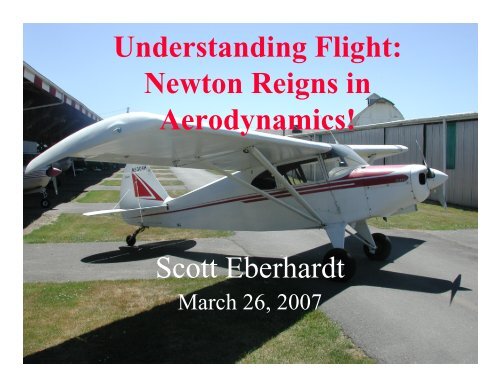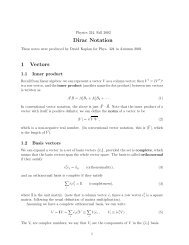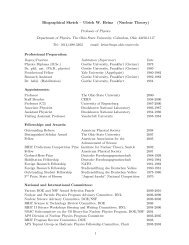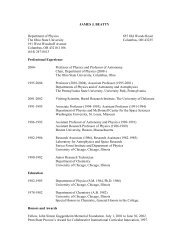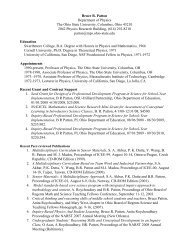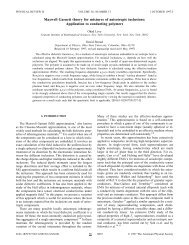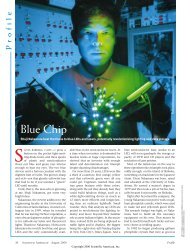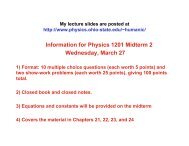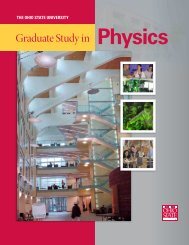Dr. Eberhardt's Talk
Dr. Eberhardt's Talk
Dr. Eberhardt's Talk
You also want an ePaper? Increase the reach of your titles
YUMPU automatically turns print PDFs into web optimized ePapers that Google loves.
Understanding Flight:<br />
Newton Reigns in<br />
Aerodynamics!<br />
Scott Eberhardt<br />
March 26, 2007
General Aviation
Military Aviation
Commercial Aviation
What you will learn today<br />
• Some of the things you learned might<br />
be wrong<br />
• The physical description of lift, using<br />
Newton’s Laws<br />
• The connection between lift and power<br />
• Some ideas about why wings look the<br />
way they do
Descriptions of Lift
Explaining Lift<br />
• Mathematical description<br />
–Taught to Aeronautical Engineers<br />
• Popular description<br />
–Taught by flight schools, FAA,<br />
NASA, etc<br />
• Physical description<br />
–What you are learning today
The Myth of the Bumblebee – The Aerodynamicist’s Bane<br />
The tabloids do<br />
it to science<br />
again?<br />
Aerodynamicist Proves<br />
Bumblebees Can’t Fly!<br />
Seattle<br />
Muckraker<br />
$1..00<br />
September 10<br />
Elvis is Alive,<br />
Living in<br />
Argentina<br />
News Flash….<br />
Britney Spears<br />
to run for governor<br />
of New York<br />
Guru remains<br />
in trance<br />
for 20 years<br />
..without food or drink<br />
A 380<br />
Giant fly<br />
devours<br />
jumbo jet<br />
…. Hundreds missing<br />
Astrophysicists find dark matter<br />
…its cosmic cow poop
The Actual Origin of the Bumblebee Myth<br />
From A. Magnan, Le Vol Des Insects,<br />
Paris: Herman and Cle, 1934 (p. 8):<br />
“Tout d’abord, pouss’e par ce qui fait en<br />
aviation, j’ai applique’ aux insectes les<br />
lois de la resistance del’air, et je suis<br />
arrive’ avec M. [Andre] SAINTE-LAGUE a<br />
cette conclusion que leur vol est<br />
impossible.”
Popular Description of Lift<br />
(what you might have learned)<br />
• Bernoulli relates pressure to<br />
velocity<br />
• Focuses on shape of wing to<br />
determine velocity<br />
• Perpetuates Myths
Physical Description of Lift<br />
“Forget Bernoulli’s Theorem”<br />
Stick and Rudder, published 1944
Lift is a Reaction Force
Physical Description<br />
• Based on Newton’s laws<br />
• Easy to understand without<br />
equations<br />
• Leads to an understanding of<br />
power required for flight
Newton’s Third Law<br />
To every Action there is an<br />
equal and opposite Reaction
Newton’s First Law<br />
A body at rest will remain at rest,<br />
or a body in motion will continue<br />
in straight line motion unless subjected<br />
to an external applied force
So….<br />
For a wing to go up<br />
it must force air down<br />
Lots of air!
Cessna Citation flying over fog<br />
(Photo By Paul Bowen)
A Rotating Wing Pushes Air Down
Does this picture show an<br />
airfoil generating lift?
No, the air must experience a<br />
net change, as shown below<br />
Upwash<br />
Downwash
Downwash<br />
Wing pulls air down -- Downwash<br />
Downwash is related to angle of<br />
attack and airspeed, which the<br />
pilot can control
Why does the air follow the<br />
top surface of the wing?
Nature Abhors a Vacuum<br />
This cannot happen
Air could fill from below?
Air could fill from below?<br />
Can’t happen (except in “superfluids”)
Air could fill from back
Air could fill from back
Stall on flat plate
Air could fill from top
Air could fill from top
Air<br />
Picture a curved hose<br />
Force
Air<br />
Hose is like an airfoil<br />
Force
Viscosity<br />
Force on glass<br />
Force on water
Newton’s Second Law<br />
The thrust of a rocket is equal to the<br />
velocity of the exhaust times the amount<br />
of mass ejected per second
Newton’s 2nd law<br />
applied to a wing<br />
The lift on a wing is proportional<br />
to the amount of<br />
air diverted per second times<br />
the vertical velocity of the air<br />
Lift = mass/sec * vertical velocity
Lift<br />
So, wing diverts air down for lift<br />
Lift = mass/sec * vertical velocity<br />
or<br />
Lift = (m/t) * V downwash<br />
(m/t) is mass flow rate of air<br />
pumped down
Diverted Air<br />
The amount of air diverted is<br />
proportional to:<br />
•The speed<br />
•The air density
The wing as a scoop<br />
The scoop can be calculated with<br />
the “Biot-Savart Law.”
Vertical Velocity<br />
The vertical velocity is proportional<br />
to:<br />
•The speed<br />
•The angle of attack
Vertical Velocity<br />
a:<br />
b:<br />
c:<br />
Speed (x2)<br />
Downwash<br />
Pilot controls airspeed and<br />
angle of attack<br />
α<br />
Speed<br />
α<br />
Downwash<br />
Speed<br />
α(x2)<br />
Downwash<br />
Vv<br />
Vv(x2)<br />
Vv(x2)
Angle of Attack
Lift is a Function of<br />
Lift<br />
1<br />
Angle of Attack<br />
Critical angle of attack<br />
5 10 15 20<br />
Effective angle of attack (degrees)<br />
(at constant density and speed)
Vertical Velocity<br />
Vertical velocity is related to<br />
angle of attack and the airspeed<br />
of the wing<br />
Pilot controls airspeed<br />
and angle of attack
How much air is pushed<br />
down?<br />
A Cessna 172<br />
diverts approximately<br />
5 times its own weight per second!
What’s going on in this photo?
Summary of Lift<br />
• Lift is proportional to:<br />
Amount of air diverted per second<br />
Downwash velocity of that air<br />
• Amount of air diverted per second is proportional<br />
to: Speed of wing<br />
Density of air<br />
• Downwash velocity of air is proportional to:<br />
Angle of attack<br />
Speed of wing
T=0<br />
Myth: 1<br />
Particles reach trailing edge at same time.<br />
T f
With Equal Transit times,<br />
How Can...<br />
• An airfoil fly upside down?<br />
• A paper airplane fly?<br />
• A wing fly in ground effect?<br />
Equal transit times says it can’t happen<br />
Equal transit times is wrong!
Reality<br />
Air goes much quicker over the top
Lift is a Function of<br />
Lift<br />
1<br />
Angle of Attack<br />
Critical angle of attack<br />
5 10 15 20<br />
Effective angle of attack (degrees)
Myth #2<br />
These two pictures are not<br />
the same thing
Cessna Citation flying over<br />
fog<br />
(Photo By Paul Bowen)
Summary of Lift<br />
• Lift is proportional to:<br />
Amount of air diverted per second<br />
Downwash velocity of that air<br />
• Amount of air diverted per second is proportional<br />
to: Speed of wing<br />
Density of air<br />
• Downwash velocity of air is proportional to:<br />
Angle of attack<br />
Speed of wing
Power
If Lift didn’t require Power<br />
• Planes would have same range<br />
empty or full<br />
• Helicopters could hover at any<br />
altitude and load<br />
• Propulsion would not require<br />
power either (same physics)
Power required for lift<br />
• Power is Force times Velocity<br />
• “Induced Power” is the lift times<br />
the vertical velocity<br />
Induced Power = Lift * Vertical Velocity
What is the Lift?<br />
•Lift = Weight<br />
(for straight and level flight)<br />
•Weight isn’t changing<br />
•Lift is constant<br />
So
How does Vertical Velocity<br />
Change?<br />
As speed increases, more air passes<br />
past wing so the amount of air diverted<br />
per second increases.<br />
Lift = (m/t) * vertical velocity<br />
or<br />
Vertical velocity = Lift/(m/t)
Therefore, as speed increases,<br />
downwash decreases
So,<br />
Induced Power= Lift * Vertical Velocity<br />
Induced Power decreases with speed!<br />
But, don’t forget power to overcome<br />
skin and form drag
Induced Power<br />
At half the speed:<br />
Half the air is diverted<br />
therefore, you need to double<br />
the vertical velocity by increasing<br />
the angle of attack<br />
Induced power goes as 1/speed
Power<br />
120<br />
100<br />
80<br />
60<br />
40<br />
20<br />
0<br />
Induced Power<br />
Cessna 172 “Skyhawk”<br />
0 20 40 60 80 100 120 140 160<br />
V - mph
Parasitic Power<br />
The energy loss to collision with the air<br />
is proportional to speed squared (1/2mv 2 )<br />
Number of collisions is proportional<br />
to speed<br />
Parasitic power goes as speed cubed
Power<br />
120.0000<br />
100.0000<br />
80.0000<br />
60.0000<br />
40.0000<br />
20.0000<br />
0.0000<br />
Parasitic Power<br />
Cessna 172 “Skyhawk”<br />
0 20 40 60 80 100 120 140 160<br />
V - mph
Power<br />
120.0<br />
100.0<br />
80.0<br />
60.0<br />
40.0<br />
20.0<br />
0.0<br />
Power Required<br />
Ve<br />
0 50 100 150<br />
V - mph
Langley’s Law
Summary of Power<br />
• Lift requires power<br />
• Power due to lift: Induced Power
Wing Efficiency
Wing Efficiency<br />
• Induced power is proportional to lift times vertical<br />
velocity<br />
• If you double the span of the wing you double the<br />
amount of air diverted and therefore halve the<br />
vertical velocity<br />
Induced Power and Induced <strong>Dr</strong>ag<br />
decrease as wingspan increases
Gliders have efficient wings
Classical Aerodynamics<br />
• Lift does no work!<br />
• But, classical aerodynamics<br />
assumes a wing of infinite span<br />
if span -> infinity<br />
power induced -> 0!
Summary<br />
• Lift is a REACTION FORCE<br />
• Lift is described using Newton’s<br />
Laws<br />
• Lift requires Power<br />
• High span increases wing<br />
efficiency
References<br />
• http://home.comcast.net/~clipper-108/Professional.html<br />
– English<br />
– French<br />
– Spanish<br />
– Italian<br />
– Japanese
Research Trends<br />
• From the University Perspective<br />
– “Smart” Structures<br />
– Active Flow Control<br />
– Coordinated and Formation Flying of UAV’s<br />
– Better Materials<br />
• From the Boeing Perspective:
Composite Structure<br />
Lower Maintenance<br />
Costs<br />
Innovative Systems<br />
Flexible for<br />
the Future<br />
Large Cargo<br />
Capacity<br />
More Revenue<br />
Potential<br />
Innovations That Add Value<br />
Breakthrough<br />
Cabin<br />
Passenger<br />
Preference<br />
Advanced Wing<br />
Enhanced<br />
Efficiency<br />
Enhanced<br />
Flight Deck<br />
Operational<br />
Reliability<br />
Advanced<br />
Engines<br />
Fuel Efficiency<br />
Lower Noise
Many Thanks!


